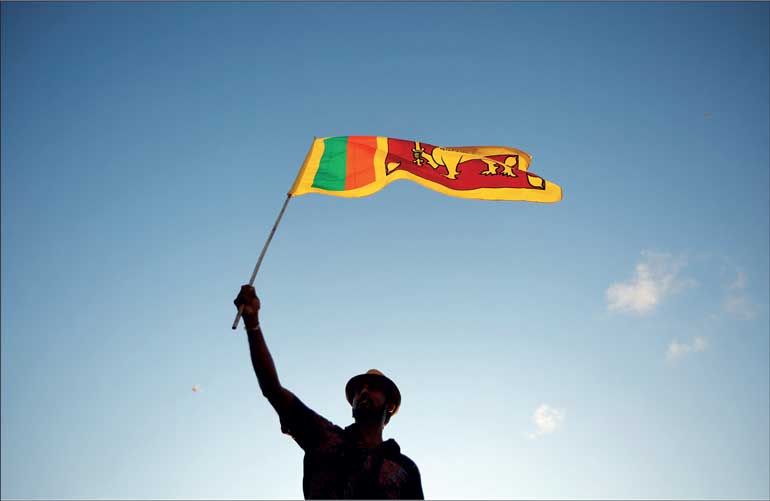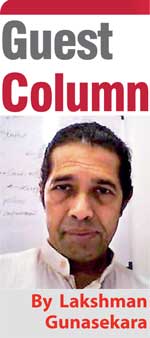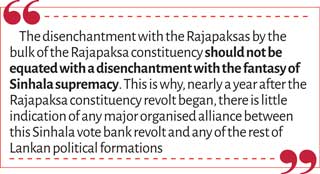Wednesday Nov 19, 2025
Wednesday Nov 19, 2025
Wednesday, 25 May 2022 00:28 - - {{hitsCtrl.values.hits}}

Is this internal contest an explicit assertion of the social right of Flag waving – that is, by the ethnically dominant citizenry?
 Horizons
Horizons
The Lion flag is waved, for a historic first time on a mass scale, in the Galle Face urban youth protest, but the violent anti-protester attackers coming from ‘Temple Trees’ also burnt those same Lion flags. Meanwhile, there are instances in this anti-regime agitation when police checkpoints giving access to Fort from Galle Face refused to allow people to carry the national flag in to the country’s centre of economy and power.
Is there an actual contest between power blocs over the use of the Flag or, is it a contest between forces within the Sinhala supremacist power bloc itself? Is this internal contest an explicit assertion of the social right of Flag waving – that is, by the ethnically dominant citizenry?
Closer observation of the current flag-waving indicates clearly that this anti-regime agitational usage is, principally and originally, the initiative of the protesting urban, ethnic Sinhala, cohort. They explicitly and proudly describe themselves as the vote bank of the Rajapaksas: the 6.9 million (69 lakh in easier vernacular).
The modern Sri Lankan practice of public political protest and non-violent civic agitation is not known to extensively use the national flag either by design or spontaneously. The use of the Lion flag by the urban youth protestors en masse in Galle Face is the very first time it seems to have happened, especially in post-colonial Sri Lanka. Until Gota Go Gama, flag-waving was largely the preserve of the State, in various modes – by State institutions at all levels, in State functions, including military functions.
Two notable exceptions of civic social practice (as opposed to State) are the hoisting of national flags in Sinhala-Buddhist weddings.
How often are national flags flown in any non-Sinhala-Buddhist formal social events? Probably never.
At the height of Mahinda Rajapaksa’s fame in politically leading the ‘Thun Hela’ Lankan republic’s battle with the ‘Tamil Eelam’ secessionists, Galle Face came to be dominated by a single giant Lion flag flying at the top of a very tall flagpole jutting upward at the centre of the Green’s sea front.
The supremacist narrative may be coming full circle: from the heady delusion of dominance to the carnage of economic collapse and political plunder. Those 6.9 millions, who wielded their ballot cards like Lion flags in electing and sustaining the Rajapaksas in power, had expected not just ethnic political supremacy but also a sustaining of their socio-economic prosperity (courtesy J.R. Jayewardena’s costly economic liberalisation).
Rural society was the first to be hit by the colossal mismanagement and remains worst hit by far. The inability to budget for fertiliser imports was hidden under an elaborate pretence of upholding organic fertiliser, which may have temporarily appealed to the patriotic fantasies of the urban component of the ‘69 Lakhs’. But the non-supply of fertiliser has been economically and socially almost fatal to Lankan agriculture, both the export sector and the entire rural society, which comprises the bigger part of the ‘69 Lakhs’. 
The lack of fertiliser has already severely reduced production and incomes in the agro-export as well as domestic food production sectors. The decline in exports also means loss of export markets. Reportedly Japan has drastically reduced future dependence on Lankan tea. This is just the tip of a deadly iceberg. The decline in food production means lower farmer income, high food costs all round and, creeping malnutrition if not famine. Ironically, the northern and southern insurgencies combined had not achieved so much economic upheaval!
Rural people, not just youth, have been frantically protesting at village level since the start of the fertiliser deprivation (ban on imports) almost a year ago. Although the News industry faithfully reported this rural protest on a daily basis for months on end, the urban component of the Pohottuwa vote bank, pre-occupied as they were with the heady fruits of ethnic hegemony and relative affluence, failed to either empathise with their rural counterparts or even foresee the impact of the financial crisis on their own lives.
The fuel, gas, electricity shortages and consequent transport, livelihood and communications disruption, were what prompted urban society to react. Here too, numerically, the Sinhala-Buddhists dominate and their angry reactions, then, convincingly present a seemingly consensual anti-regime configuration. But ‘consensus’ is precisely what it is not.
Gota Go Gama is both a media-facilitated impressionistic hyperbole (“youth rebellion”) as well as a hard political indicator of a considerable undermining of the Rajapaksa-led current political leadership of Sinhala supremacism.
This phenomenon of disenchantment of the Sinhala supremacist vote bank must, firstly, be noted for its lack of politically organised coordination between the rural cohort and its urban counterpart. There is no organised coordination because no new leadership has replaced the rejected Rajapaksas. The Sinhala farmers are spontaneously revolting in their impoverished desperation and lack political coordination even among themselves. The parallel Sinhala urban youth cohort has also spontaneously revolted but with some internal (inter-urban, diaspore) coordination thanks to social media usage and also their greater affluence which enables sustained protest tactics like camps in city centres. 
Secondly, both these rebelling Pohottuwa cohorts that now reject the Rajapaksas, had, combined previously, in successive elections, to summarily reject all other possible political leaderships on principally ideological grounds as not trustworthy of building and sustaining Sinhala supremacy.
Thirdly, these two parallel Rajapaksa constituency ‘revolts’ are actually late-comers to an already on-going substantive political resistance to the Rajapaksa-led imposition of a corrupt, authoritarian, ethno-supremacism. This political resistance, both in parliamentary opposition and outside, is articulated by the entirety of the rest of Lankan political formations: the more liberal Sinhala-led political forces (UNP, SLFP, SJB), Sinhala-led Left political formations (JVP, FSP) and also, the bulk of the ethnic minority-led political forces.
The disenchantment with the Rajapaksas by the bulk of the Rajapaksa constituency should not be equated with a disenchantment with the fantasy of Sinhala supremacy. This is why, nearly a year after the Rajapaksa constituency revolt began, there is little indication of any major organised alliance between this Sinhala vote bank revolt and any of the rest of Lankan political formations.
That revolting Rajapaksa vote bank remains ideologically alienated from these other forces which have been saying some (not all) of the same things for nearly two decades. The other Sinhala-led forces, both Liberal and Left, cannot be trusted to sustain the current, constitutionally affirmed and, politically protected and enhanced Sinhala ethnic hegemony. That is the meaning of the wild rejection of all 225 parliamentarians.
However, in the current fluid political environment, it remains to be seen how this need for a supremacist political ‘spear-head’ might be modulated by an absence of such a spearhead. The currently emerging alliance between the besieged, but yet numerically secure, Pohottuwa parliamentary group and, the barely Liberal, electorally discredited, remnant of the UNP embodied by its sole MP, Ranil Wickremesinghe, could be a first test for the rebellious Pohottuwa vote bank. Repelled by this new alliance, will the ex- Pohottuwa vote bank opt for a less ultra-nationalist leadership which might come forward from any other Sinhala-led formation?
“They’ll call me Freedom, just like a waving flag…” goes the song ‘Wavin Flag’ by US Rapper K’naan which became a global hit in 2009. The song is all about how the dominant forces in society get the masses to wave the flag but, after enthusiastically waving the flag (and dying for it), those same masses find that their ‘freedom’ is restricted to flag-waving and dying. They remain socio-economically oppressed. The song graphically describes that continuing oppression: “…violent prone, poor people zone…” and, “So we struggling, fighting to eat…” Will this soon happen here?
As this writer learned after visits to the GGG campsite and conversations with these young formerly Pohottuwa protestors, this constituency is amazingly naïve having being shielded from minority ethnic agitation by the counter-insurgency victory, as well as not knowing a social past of deprivation and intensive economic class struggles. Thus, they have little idea of the degree of ethnic oppression and alienation of the ethnic minorities from the electoral mainstream. And their urban affluence kept them distant from rural economic struggles and previous semi urban protests.
This ethno-centric urban youth protest, therefore is characterised by their own political-cultural exclusivity, even isolation. Their affluent interactions with global culture and with the diaspora inspired them to use the Lion flag as the expressive symbol of their patriotic anti-Rajapaksa revolt. So we have Lion flag waving en masse initiated by the rebellious Pohottuwa urban youth. To these flag-wavers, Lanka is a Sinhala world after all.
In fact, in this appropriation of the State ensign for their own spontaneous flaunting – as opposed to exclusive, formal, State usage – these angry Pohottuwa protestors are deliberately exercising their Sinhala sovereignty over State and Presidency as the ‘true’ constituents of the Republic. Lion flag-sellers are having a field day at Galle Face these days – in place of the kite-sellers. Small groups of ethnic minority citizens visiting Galle Face have wisely borne Lion flags. Remember that the Green has been the sole evening promenade available to generations of central Colombo dwellers – the majority of whom are Muslim and Tamil.
The non-coordination between the Pohottuwa rebellion and the rest of the anti-Rajapaksa-SLPP political opposition betrays the divergence in motivation and long term political goals. The Pohottuwa rebels remain within that ‘69 Lakhs’ Sinhala supremacist movement. They proudly proclaim their ‘69 Lakhs’ identity – the very identity explicitly and proudly described by President Gotabaya Rajapaksa as “exclusively” Sinhala-Buddhist from his very first presidential address onwards. Even today, it is that same bloc vote that he uses as the excuse for remaining in office.
The ethnic minority political leaderships have no illusions whatsoever about the continuity of supremacist power. Neither do the parallel Sinhala-led political parties both Liberal and Left. Especially the Sinhala-led formations are busy mingling with the GGG and other urban protest centres elsewhere in order to milk whatever political leverage possible. In their GGG mingling they are extremely polite and avoid claiming any ideological or political convergence other than the economic crisis and plunder issues. Established parliamentary Opposition politicians are studiously distant from the Green.
Those liberal citizens hoping for greater ethnic harmony are romanticising the so-called “youth protest movement” as being multicultural, simply because they see some multi-ethnic mixing of protesters within their own social class circles. It is crucial that even small elements of such spontaneous cultural blending be encouraged as valuable reversals of the ethnic warfare incited these past decades. Certainly, in the greater urban ethnic mixture, there is some inter-ethnic solidarity over the common gas-fuel-electricity shortage.
A comment by a popular Sinhala TV channel news anchor, made soon after the Emergency was imposed for the second time, is noteworthy. He echoed the popular expression that the Emergency and curfews were intended to suppress the protests over the fuel-gas-electricity shortage. Once these essential supplies are brought to normalcy, then the Government was free to impose Emergency for any other purposes, he argued. The implied logic was that the Emergency could be used to suppress other agitations – by minorities? Unions? He did not say. Evidently, the issue for him was the current deprivations felt by the large protesting Pohottuwa constituency and not so much the spectrum of democratic rights. It was as if this TV personality had forgotten the decades of abuse of Emergency powers to suppress the whole gamut of public agitation and dissent.
There is now a sizeable chunk of the Lankan electorate that is up for grabs – not by anyone, though. Much calculating is on by various Sinhala political leaderships – ultra nationalist, Liberal, Left – as to how at least portions of the ‘69 Lakhs’ could be lured over. Some Opposition personalities will calculate how much Sinhala supremacist discourse they must adopt to do the luring. The Pohottuwa political leadership itself, with its Viyath Maga business-intelligentsia support group, must also be exploring personality combinations that might pick up where the Rajapaksas left off.
The weakest elements of the now disenchanted Pohottuwa constituency are the farmer society (not the agri-business corporates) and the poorest semi-urban working class, both sectors being the worst hit by the economic crisis. Unlike the urban middle and upper classes, their deprivation is not merely utilities and services shortages. Their very livelihoods are directly threatened.
Will this existential threat be enough for these most subaltern of Sinhala sectors to move beyond ethnic supremacy/security compulsions and toward political movements that offer new social and economic measures? Certainly, the JVP and smaller Left groups are seeing lots of possibilities.
So are the anxiously watching foreign powers both in Delhi and in NATO-EU. From their point of view, Gotabaya Rajapaksa is better than any Left options. These foreign powers are clearly un-enthusiastic about the untested Sajith Premadasa and his fairly representative and balanced Liberal coalition. From this foreign viewpoint, Ranil Wickremesinghe, who served as Premier in the far more repressive Ranasinghe Premadasa regime would be the ‘safest bet’. Is this why Wickremesinghe agreed to take Premiership under his political enemy?
Is this a marriage of secular right-wind autocracy with racist supremacism? Fortunately, reassuringly, the most prominent characteristic of this new combination is their persistent record of incompetence and failure.
Civilised Lanka, both Liberal and Left, may have the last word – after a breathing space to allow for re-grouping and expansion of mass mobilisation. ‘The Economy’ is not necessarily always priority No. 1 as even the enlightened business leaderships will acknowledge.